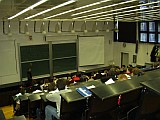
U ponedjeljak, 30.9.2013., u 14:30 (Seminar TZ 201, 2. kat, Fizički odsjek) biti će održano sljedeće predavanje:
Elisabete da Cunha (Max-Planck-Institute for Astronomy, Heidelberg, Germany)
Empirical predictions for (sub-)millimeter line and continuum deep fields
Modern (sub-)millimeter/radio interferometers such as ALMA, JVLA and the PdBI succes- sor NOEMA will enable us to measure the dust and molecular gas emission from galaxies that have luminosities lower than the Milky Way, out to high redshifts and with unprecedented spatial resolution and sensitivity. This will provide new constraints on the star formation properties and gas reservoir in galaxies throughout cosmic times through dedicated deep field campaigns targeting the CO/[CII] lines and dust continuum emission in the (sub-)millimeter regime. I will present empirical predictions for such line and continuum deep fields. We base these predictions on the deepest available optical/near-infrared data on the Hubble Ultra Deep Field. Using a physically-motivated spectral
energy distribution model, we fit the observed optical/near-infrared emission of 13,099 galaxies with redshifts up to z=5, and obtain estimates of their stellar mass, star formation rate, dust attenuation and dust luminosity. We combine the attenuated stellar spectra with a library of infrared emission models spanning a wide range of dust temperatures to derive statistical constraints on the dust emission in the infrared and (sub-)millimeter which are consistent with the observed optical/near-infrared emission in terms of energy balance. This allows us to estimate, for each galaxy, the (sub-)millimeter continuum flux densities in several ALMA, PdBI/NOEMA and JVLA bands. As a consistency check, we verify that the 850μm number counts and extragalactic background light derived using our predictions are consistent with previous observations. Using empirical relations between the observed CO/[CII] line luminosities and the infrared luminosity of star-forming galaxies, we infer the luminosity of the CO and [CII] lines of each galaxy in our sample. We use our predictions to discuss possible deep field strategies with ALMA. The predictions presented in this study will serve as a direct benchmark for future deep field campaigns in the (sub-)millimeter regime. I will also briefly discuss the effect of the cosmic microwave background on high-redshift (sub-)millimeter observations.